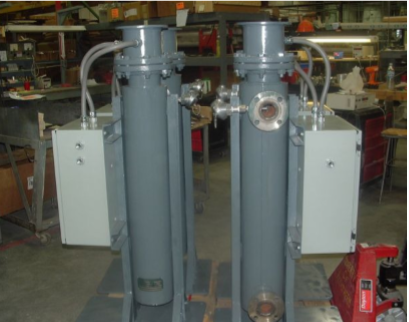CIRCULATION HEATERS
STS offers high quality circulation heaters, suitable for heating liquids and gases. Compact and efficient, circulation heaters may be used in forced or natural circulation systems to heat flowing gasses or liquids. Pipe plug or Flanged immersion heater, vessel, insulation, terminal enclosure, mounting brackets and inlet and outlet connections are included. Installation is simple with only basic wiring and piping connections required. An integral thermostat is available if required. An installation and maintenance manual is supplied with each Circulation Heater.
Screw Plug Circulation Heaters feature Incoloy® 840 sheath for the widest coverage of applications and temperatures, NEMA 4 moisture tight enclosure, sediment drain, and NPT inlet/outlet.
Flanged Circulation Heaters feature Incoloy® 840 sheath for the widest coverage of applications and temperatures, NEMA 4 moisture tight enclosure, sediment drain, and 150 lb flanged inlet/outlet.
High Capacity Flanged Circulation Heaters feature Incoloy® 840 sheathed elements, carbon steel pipe body with 2″ high temperature insulation, and digital LED solid state control (0-1000 deg F) with thermocouple in outlet.
Suction Oil Circulation Heaters feature Incoloy® 840 sheath for the widest coverage of applications and temperatures, NEMA 4 moisture tight enclosure, and sediment drain. They are suited for large storage tanks of viscous fluids.
HEATER FEATURES
- Incoloy® 840 sheath standard on all items except suction oil heaters-allows for the widest coverage of applications and temperatures, plus gives a margin of safety for unknown corrosives or contaminants.
- High purity MgO powder compacted to provide maximum heat conductivity and optimum dielectric strength.
- Type ‘A’ 80/20 resistance wire sized to provide lowest wire watt density for maximum life.
- Fusion welded junction between pin/resistance wire to provide a 360″ circumferential joint, giving superior strength and life.
- Recompacted bends to restore MgO density in bend areas.
- Moisture sealed to prevent the entrance of contaminants during storage and service. Silicone end seals on heaters for oil, air and corrosive applications. Epoxy seals for water applications.
- NEMA 1 wiring enclosure, NEMA 4 moisture tight enclosure on high capacity and suction heater units.
- Element spacer supports on multi-element heaters whose length exceeds 18″.
- Thermowell for sensing bulb of thermostat.
- UL & CSA Recognition on elements.
VESSEL FEATURES
A. Galvanized pipe on most water heaters, carbon steel pipe on others.
B. 1″ fiberglass insulation on all pipe bodies except where noted.
C. Painted steel shroud encasing insulation.
D. Heavy duty mounting lugs on larger units (2″ plugs and UP).
E. NPT inlet/outlet on sizes up to 8″ flange, flanged inlet/outlet on larger sizes.
F. Top or side mounted bulb and capillary thermostats standard on sizes through 8″ flange. Solid state controls on high capacity air and gas heaters.
G. All welded construction hydrostatically pressure tested for leaks. ASME Section 8 vessel available upon request.
H. Sediment drains standard on all liquid applications.
watt density per application
- 90 Watts Per Square Inch – For heating clean water only in commercial and/or residential applications. Element life is sacrificed in favor of a low initial heater cost.
- 60 and 45 Watts Per Square Inch – Industrial water heating – many aqueous solutions which are compatible with steel and Incoloy.
- 23 and 20 Watts Per Square Inch – For heat transfer oil, cleaners, high temperature air and gas heating.
- 15 and 12 Watts Per Square Inch For lubricating oils, medium viscosity oils, high temperature air and gas heating.
- 8 and 6 Watts Per Square Inch – For #5 and #6 fuel oil heating, viscous materials, raw crude oil, residual oils, high temperature air and gas heating.





